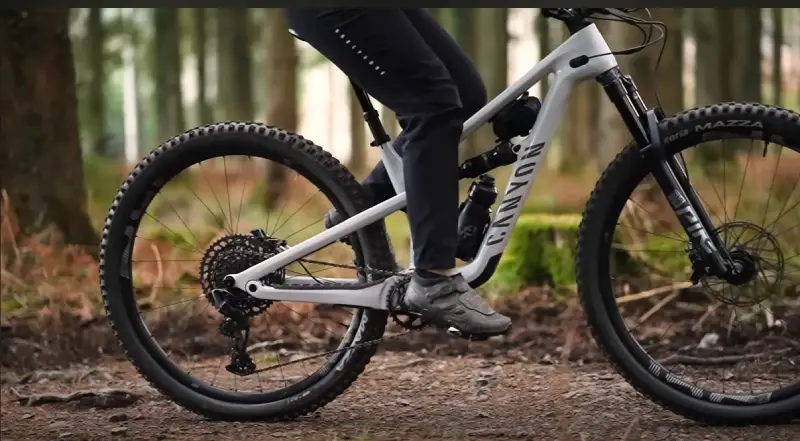Patellar tendonitis can occur when the patellar tendon is inflamed or irritated due to overuse or improper form while cycling. It can cause pain, stiffness, and swelling in the knee area, making it challenging to pedal or walk. It’s a serious issue that has caused many athletes to have to sit out of competitions or even retire from their sport altogether.
Patellar tendonitis, which can cause trouble with the front of the knee, can be caused by cycling saddle that is too low or too far forward. Raising the saddle and moving it slightly back is recommended to alleviate patellar tendonitis. Making these adjustments in small increments is essential to avoid causing other issues.
In this blog post, we’ll explore factors affecting cycling saddle height adjustment and adjusting tips on saddle height to prevent. The benefits of adequately adjusting a bike’s saddle height.
Patellar Tendonitis Cycling Saddle Height: 4 Prevention Steps

As a cyclist, adjusting your bike’s saddle height is crucial. This is because the correct saddle height enables you to pedal smoothly and reduces the risk of injuries such as patellar tendonitis. Several factors affect the adjustment of cycling saddle height.
Rider’s Height
A rider’s height is an essential factor in adjusting the saddle height. The taller the rider, the higher the saddle should be set. Conversely, shorter riders will require a lower saddle height. A general rule to follow when determining the saddle height is to measure the inseam or inside leg and multiply it by 0.883. This measurement will give you a guideline to set your saddle height.
Rider’s Leg Length
The length of your legs also plays a significant role in saddle height adjustment. When setting the saddle height, ensure your knee is slightly bent at the pedal’s lowest point. Very often, when the saddle is too high, the rider can develop patellar tendonitis caused by the added pressure on the knees, especially when cycling for long distances.
Rider’s Riding Style
A rider’s cycling style should also be considered when adjusting the saddle height. Riders who cycle competitively or for longer distances tend to sit more upright, requiring the saddle height to be higher. Conversely, riders who engage in more aggressive cycling, such as mountain biking, prefer their saddle height to be lower.
Bike Frame Size and Type
The size and type of bike being used can influence the saddle height adjustment. If you’re using a more petite frame, you may need to adjust the saddle height to a slightly lower position. Additionally, some types of bikes, such as road bikes, require a higher saddle position to achieve maximum efficiency because they are designed for speed.
Footwear
The shoe type worn when cycling is also a vital consideration. If thick-soled shoes are worn, the saddle height may be slightly higher to avoid discomfort or injury from a cramped cycling position. Conversely, thin-soled shoes may require a lower saddle height to prevent riders from straining their hips.
6 Tips for Adjusting the Saddle Height of a Cyclist for Patellar Tendonitis
Cyclists are particularly susceptible to this condition due to the repetitive cycling motion. However, changing the height of your cycling saddle can help alleviate the strain on your patellar tendon and reduce the risk of developing this painful condition. Here are some tips for adjusting your cycling saddle height to patellar tendonitis.
Measure Your Inseam
The first step in adjusting your saddle height is accurately measuring your inseam. This measurement is crucial because it provides the basis for the saddle height adjustment. The ideal saddle height is generally 109% of your inseam length.
Start Low and Work Your Way Up
start with a lower height and then gradually increase. This gradual increase allows you to find the perfect saddle height that works best for you and reduces your risk of developing patellar tendonitis.
Avoid Overextension
One important thing to keep in mind when adjusting your saddle height is that you should avoid overextension. Overextension of the knee can lead to patellar tendonitis. When you pedal, your foot should be parallel to the ground, and your knee should be slightly bent.
Use a Chair or a Wall
Another helpful tip for adjusting your saddle height is to use a wall or chair. This method helps you determine if your saddle is at the correct height by placing the heel of your foot on the pedal and ensuring that the leg is completely straight when positioned at the bottom of the stroke.
Get a Professional Fitting
If you struggle to find the right saddle height or have patellar tendonitis, consider getting a professional fitting. A professional fitting will ensure the saddle height is correctly adjusted to your measurements and reduce your risk of developing injuries.
Listen to Your Body
Listening to your body while adjusting the saddle height is essential. If you experience any pain or discomfort, stop, adjust your saddle, and try again. The perfect saddle height will allow you to pedal comfortably without any distress.
4 Benefits of Proper Cycling Saddle Height Adjustment

Adjusting your saddle height properly can prevent patellar tendonitis and provide a more comfortable and efficient cycling experience. There are several benefits of changing your cycling saddle height appropriately:
- Reduced Risk of Patellar Tendonitis: When saddle height varies too much, it may cause unnecessary strain on the knees, causing patellar tendonitis. Proper saddle height adjustment helps reduce this risk by distributing the load evenly across your leg muscles.
- Improved Comfort and Performance: Proper saddle height adjustment can help you find a comfortable position and improve your pedaling efficiency, resulting in better performance and longer rides.
- Better Power Transfer: When you adjust the saddle height correctly, you can transfer more power from your legs to your pedals, resulting in a more efficient and effective cycling experience.
- Improved Muscle Efficiency: Adjusting your saddle height properly enables your leg muscles to work more efficiently, leading to better muscle development and endurance.
Cycling Saddle Height for Preventing Patellar Tendonitis
Avoiding patellar tendonitis, a common concern among cyclists, involves various preventive measures, including adjusting cycling saddle height. Understanding the significance of saddle height and its impact on preventing this condition is crucial for cyclists.
Importance of Proper Saddle Height
- Alignment and Comfort: Adjusting saddle height to align with proper leg extension when pedaling ensures comfort and reduces strain on the patellar tendon.
- Reduced Stress on Knees: Correct saddle height distributes force evenly, reducing excessive knee stress and decreasing the risk of patellar tendonitis.
Warm-Up and Stretching
- Pre-Cycling Routine: Incorporate warm-up exercises and gentle stretches targeting leg muscles to prepare them for cycling, reducing strain on the patellar tendon.
- Post-Cycling Stretching: After cycling, perform cooldown stretches to alleviate muscle tightness, supporting overall knee health and preventing tendonitis.
Gradual Intensity Increase
- Progressive Approach: Gradually increase cycling intensity and duration to avoid sudden stress on the patellar tendon, allowing tendons to adapt to the workload.
- Listen to Body Signals: Pay attention to any discomfort or pain during cycling and adjust the intensity to prevent knee
Proper Nutrition and Hydration

- Hydration Importance: Stay hydrated during cycling sessions to support joint health and tendon flexibility, reducing the risk of tendon-related injuries.
- Nutrition for Recovery: Consume a balanced diet rich in nutrients essential for tendon health to aid in recovery and repair post-cycling.
Recovery and Rest
- Rest Periods: Allow ample rest between cycling sessions to prevent overuse injuries, giving time for tendons to recover and strengthen.
- Quality Sleep: Prioritize quality sleep as it plays a vital role in tissue repair and overall musculoskeletal health.
Conclusion
Patellar tendonitis is a common condition that affects many cyclists and can be attributed to several factors, such as overuse, sudden changes in training intensity, and improper bike fit. However, with the proper precautions, including adjusting your cycling saddle height, you can prevent this painful and debilitating condition.
Ensuring your saddle height is adjusted correctly will enable you to enjoy your cycling experience without experiencing knee pain or injuries. Remember, the key to preventing patellar tendonitis is to maintain proper cycling form, avoid pushing yourself too hard, and always listen to your body.
FAQs
How Does Cycling Saddle Height Affect Patellar Tendonitis?
The height of the cycling saddle can significantly affect the development and severity of patellar tendonitis. If the saddle is too low or too high, it can increase stress on the knee joint and the patellar tendon, leading to inflammation and pain.


